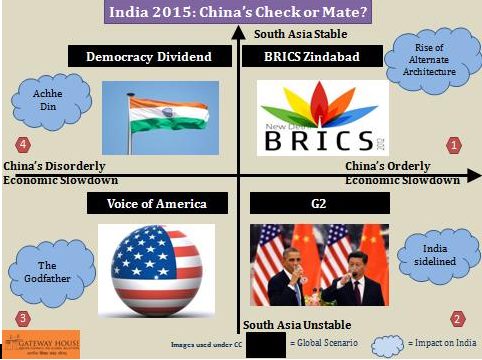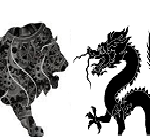2015: The year that India can. A new, wants-to-do government. A system that’s cranking up once more. Stalled infrastructure projects being revived. Jobs matter again. Ecologically sustainable business models are being considered. Tech on the rise. States taking more of the initiative. A controlled fiscal deficit due to unexpected savings from falling oil prices. A proactive foreign policy has raised India’s profile. Economic diplomacy has re-ignited investor interest. A free-trade agreement with ASEAN fulfils the Acting East promise. Securing our neighbourhood with active diplomacy and aid, to ensure stability in South Asia. So what can change this promising picture? In a word, China. At every step, India will come up against the great wall of China – to our benefit or to our detriment. Will China check or charm India? Like India, China too is in high gear.
Regionally, it is an economic and geopolitical aggressor. Its giant $9 trillion economy has plateaued, forcing it to expedite its move towards an open economy. The world’s factory is now focused on becoming a consuming economy too. Technology imitation is giving way to genuine innovation. China has gigantic exports but its massive aid now dominates financing in Asia, Africa and Latin America – sometimes more than that of powerful multilateral agencies like the World Bank or bilateral agencies like the US Exim Bank. It’s acquiring energy assets on the earth, and securing a place in space, beyond the moon to Mars. The People’s Liberation Army has aggressively advanced influence into Central Asia, Pakistan, Nepal and is adventuring into India. Its navy already asserts itself in the South China Sea and is now seeking parity in the Indian Ocean with other naval powers. It’s on a mission to replace America in a unipolar world. These ambitions require varied levels of adjustment by China, a tuning that is already evident from the slowing of its economy. This is natural, as a developing country stabilises and moves to more advanced levels.
The question is: will China’s adjustment be orderly, or disorderly? A methodical realignment will require Beijing to rein in its extravagant public spending by instituting prudent lending by its banks and reduced foreign aid and acquisition programmes. A disorderly slowdown will disrupt the financial system, perhaps causing damage to domestic banks, property prices to crash and manufacturing to slow. In turn this will impact China’s domestic employment and wages, and global trade and financial linkages.
From the Indian perspective, two determinants will influence world affairs in 2015. China, as explained above, is the dominant one. The second is stability in our neighbourhood, in particular, security risks emanating from Pakistan and Afghanistan. Another Mumbai-style attack in India, a military coup in Pakistan, the resurrection of Taliban in Afghanistan, the resumption of anti-India terrorist groups in Bangladesh, and rising inequality and resident insurgencies in India – these can all destabilise South Asia. Energy, which until now, would have competed as a determinant, is no longer a risk for India in 2015 – barring geopolitical shocks or natural catastrophes in the producing regions.”
The world is in the low point of a boom-bust oil cycle, which, thanks to viable alternate energy finds, could last two decades. Gateway House has developed four scenarios, to explain the outcomes that will ensue, starting 2015, when these two determinants intersect.  1. A stable South Asia that intersects with an orderly slowdown in China will strengthen the rise of the South and its effort to create an alternate political and economic architecture that more accurately reflects its own conditions and global heft. Forums like BRICS will lead the way. BRICS, Zindabad.
1. A stable South Asia that intersects with an orderly slowdown in China will strengthen the rise of the South and its effort to create an alternate political and economic architecture that more accurately reflects its own conditions and global heft. Forums like BRICS will lead the way. BRICS, Zindabad.
Impact on India: India and China will have a more equal voice in creating alternate global governance structures.
2. Unstable South Asia that overlaps with an orderly Chinese economic slowdown will strengthen China’s authority in new institutions, even as it increases its influence in the existing world order. China will be on course for parity with the United States, resulting in a G2.
Impact on India: India will be sidelined, as it will no longer be required as the swing power. The US and China will be making the global decisions, not necessarily in our interest. India excluded from new global trade agreements like TTP, FTAAP.
3. If both South Asia and China are unstable – South Asia because of security, and China because of the economy – then the US will consolidate its power and retain its unipolar dominance. Co-operation with Pakistan for a tidy drawdown of troops from Afghanistan is on the cards, as is a surrender by India on trade and climate change negotiations. The dollar strengthens with the US exercising ‘exorbitant privilege.’ BRICS and G20 recede in importance, and the World Bank and IMF call the shots again. The Voice of America will be gospel. Impact on India: The US will become India’s godfather – pre-eminent arms provider, and pressure will mount to assist US in military interventions in West Asia. The US will disregard IPR issues to promote its multinationals. It will be back to the 1970s, when India depended on the US for capital, technology and innovation.
4. A stable South Asia combined with a disorderly Chinese economic slowdown will reinforce Democracy Dividends – The vibrancy of private sector-led entrepreneurship, public participation in political processes, adoption of business models that serve both stake-holders and shareholders, and framing of equitable policies.
Impact on India: Achhe din, for sure. Focus away from counter-insurgency and law-and-order issues. World will look to India as a reliable alternative to China for goods and services – giving us room to grow, sustainably.
Recommendations for India:
Scenario 1: BRICS Zindabad -Promote a non-dollar architecture, in the face of stiff resistance from the West. -Institutionalise a decentralised model of renewable energy generation for bottom-up wealth creation. ,
Scenario 2: G2 -Never waste a good crisis: follow up reforms for governance, national security, and electoral processes -Strengthen relations with other stagnant powers like the EU, and Japan, and actively excluded powers such as Russia
Scenario 3: Voice of America -Focus on building the Asian Security Quadrilateral – US, Japan, Australia, India – and call on promised US support for UN Security Council permanent membership. -Resist IPR pressures on pharma and agriculture.
Scenario 4: Democracy Dividends -Influence global policy away from militaristic solutions, re-experiment with non-violence -Increase women in the workforce as cornerstone of Make in India campaign.
Methodology: The above is broadly based on the Net Assessment method, usually used to prepare policy-makers for scenarios that are or are not likely to occur in the future. The above process produced 48 scenarios, viewed through the lens of 16 major categories: Trade, Currency Wars, Terrorism, Inequality/Democracy, China’s growth, Climate Change, South Asia, Iran & West Asia, Chinese aggression targeted at India, Fight for Multilateral & Regional Dominance, Disasters & Pandemics, Technology-enabled Aggression, Energy. ———————————————————————————————————– Research Team:
- Geopolitics: Neelam Deo
- Geoeconomics: Rajrishi Singhal, K N Vaidyanathan, Akshay Mathur
- Energy: Amit Bhandari
- Security: Sameer Patil
- Democracy and Nation-Building: Rajni Bakshi
Editor: Manjeet Kripalani
Researchers: Karan Pradhan, Sharmadha Srinivasan
Akshay Mathur is Geoeconomics Fellow and Head of Research at Gateway House
This article was exclusively written for Gateway House: Indian Council on Global Relations. You can read more exclusive content here.
For interview requests with the author, or for permission to republish, please contact outreach@gatewayhouse.in.
© Copyright 2014 Gateway House: Indian Council on Global Relations. All rights reserved. Any unauthorized copying or reproduction is strictly prohibited


